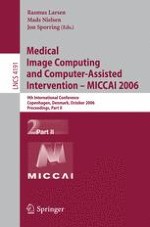The 9th International Conference on Medical Image Computing and Computer Assisted Intervention, MICCAI 2006, was held in Copenhagen, Denmark at the Tivoli Concert Hall with satellite workshops and tutorials at the IT University of Copenhagen, October 1-6, 2006. The conference has become the premier international conference with - depth full length papers in the multidisciplinary ?elds of medical image c- puting, computer-assisted intervention, and medical robotics. The conference brings together clinicians, computer scientists, engineers, physicists, and other researchers and o?ers a forum for the exchange of ideas in a multidisciplinary setting. MICCAI papers are of high standard and have a long lifetime. In this v- ume as well as in the latest journal issues of Medical Image Analysis and IEEE Transactions on Medical Imaging papers cite previous MICCAIs including the ?rst MICCAI conference in Cambridge, Massachusetts, 1998. It is obvious that the community requires the MICCAI papers as archive material. Therefore the proceedingsofMICCAIarefrom2005andhenceforthbeing indexedbyMedline. Acarefulreviewandselectionprocesswasexecutedinordertosecurethebest possible program for the MICCAI 2006 conference. We received 578 scienti?c papers from which 39 papers were selected for the oral program and 193 papers for the poster program.
